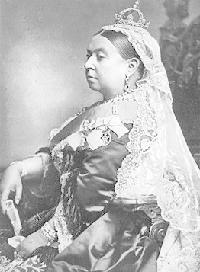 |
| Queen Victoria |
|
n the year 1887, England was celebrating her Queen Victoria’s Golden Jubilee, the grand national celebration of her majesty’s 50th year as Queen. Victoria's long reign witnessed the expansion of the British Empire and an evolution in scientific discovery, mechanical achievements, and cultural pastimes.
British inventors were busy demonstrating their modern miracles for making life more comfortable, enjoyable and endurable for the world’s growing populace—utterly transforming the face of material life with inventions like the electric motor, the steam engine, the telegraph, photography, the first programmable calculating machine, the waterproof raincoat, the sport of rugby, and the ladies game of lawn tennis.
Yet, England’s chief export was really the national pride associated with the name of her popular Queen. The term “Victorian England” reflected much more than the mere political evolution and economic progress driven by British initiative: it flowed directly from the Queen's ethics, style and personal tastes—which generally reflected those of the middle class and the prosperity they were beginning to enjoy.
|
 |
| Andrew Jackson Hart |
|
Dr. Andrew Jackson Hart, living a world away in Modesto, California, no doubt read with great fascination the newspaper accounts of the Golden Jubilee festivities in England. He had long since joined the prosperous middle class, having by the age of 55 established a successful medical practice, together with the wealth and standing in the community that his success provided him. Unfortunately, progress in medicine had not yet caught up with the mechanical innovations that distinguished the 19th century. Dr. Hart had been suffering from respiratory problems, exacerbated by the long hot summers of Modesto.
It was at a time—decades before the advent of air conditioning—and place where the summer temperatures, reaching an average high in the upper 90s, could make every day living oppressive. One day, Dr. Hart stumbled across an advertising brochure entitled, Pacific Grove Retreat, The Peerless Sea-side Resort and Camping Ground—Announcement for Summer Season 1887. This multi-page brochure, published and distributed throughout northern California by the Southern Pacific Railroad Company, extolled the virtues of Pacific Grove:
"In beauty of location it cannot be excelled—its graceful pines extending to the water’s edge, affording a delightful refuge from the heat of the sun. It has long been established as a medical fact, that a residence in a country wooded with pines is peculiarly beneficial for all those suffering from bronchial or throat infections. As a healthful place of resort, it is not surpassed by any locality in the State.
"...The climate is all that can be desired, being remarkably equable, varying but little during the year and is far milder than any place further north. Oppressively warm days are unknown, and it is seldom unpleasantly cold. The encampment is unsurpassed for grandeur and beauty of scenery, commanding a splendid view of the Bay of Monterey, and in close proximity to the Light House, and within a morning’s walk of that pearl of beauties, Cypress Point."
The brochure also described in great detail the public and private facilities of the town, including everything from its water supply to its skating rink, with assurances of its “moral and prudential management,” a map of the lots for sale, an extensive description of the newly-erected El Carmelo hotel, and detailed etchings depicting the hotel, the beach (near present-day Lover’s Point), and the bewitchingly beautiful cypress trees at Cypress Point.
Pacific Grove—with its ever-temperate climate, sea air, and pine-infused atmosphere—seemed like the perfect summer getaway. Probably in the summer of 1889, the Harts took a family vacation to explore a summer at this “delightful refuge” among the pines. They probably stayed at the new El Carmelo Hotel, which was located on Lighthouse Road, where the present-day Holman Building stands. The summer of 1889 spent in the piney paradise must have confirmed everything the good doctor and his wife first read about the Pacific Grove Retreat.
By the end of the summer, Dr. Hart and his wife were convinced that this was the place to live out their retirement years and build a future for their family. Dr. Hart identified one of the largest parcels of property in the retreat and promptly made arrangements to buy it. Like many buyers of property, he probably hadn’t thought of the history of the vacant lot that was soon to become his home. That lot, and all of the lots within the Pacific Grove Retreat, had indeed a remarkable history, one which began in the modern era over 300 years before Dr. Hart set his eyes on the beautiful Monterey Bay.
|
|